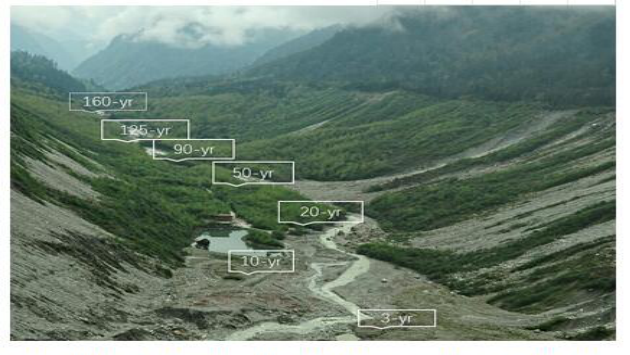The continuous warming of the global climate has led to rapid reduction in the area of glaciers in high mountains and polar regions, consequently caused the mercury originally in glaciers evaporate into the atmosphere and ecosystems. Vegetation absorbs mercury in the atmosphere, which has always been considered as an important medium to deposit mercury in the atmosphere. But the process and mechanism of vegetation absorption in mercury during the primary succession in glacial retreat areas contribute to acquiring new information and details.
The research team has been led by LUO Ji from Institute of Mountain Hazards and Environment,CAS and FENG Xinbin of Guiyang from Institute of Geochemistry, CAS for a long time to conduct a comprehensive study on Hailuogou glacial retreat area with the support from Gongga Mountain Station. New progress has been made in exploring the relationship of source and sink between glacial ablation and mercury during vegetation succession in glacial retreat areas under climate warming conditions.
The research shows that the productivity of vegetation in succession increased rapidly in Hailuogou glacial retreat, with atmospheric Hg0 as the main source of mercury in soil. But there were some differences between Mingyong Glacier and Midui Glacier in lower growth of biomass and productivity. The concentration of mercury in soil decreases with the increase of soil depth, and the concentration of mercury in surface organic soil is usually higher than in deep soil and bedrock with one order of magnitude. The simulation results of isotopic and Hg MIF mixed models show that in the soil organic layer and C layer of Hailuogou glacial retreat area, the mercury storage produced by atmospheric deposition continues to increase with the succession process of vegetation, and the soil organic layer is the most important atmospheric mercury deposition reservoir instead of litter.
SOC-Hg models have also been used to estimate the impact of atmospheric deposition on mercury reservoirs in other glacial retreat areas around the world, and vegetation succession sequences in glacial retreat areas can fully absorb the mercury released by melting glaciers and become atmospheric mercury sinks. The "Global warming accelerates uptake of atmospheric mercury in regions experiencing glacier retreat" collaborative research results was published in the international leading journal PNAS in January 2020.
Detailed reports and comments in EOS as the authoritative release platform for global earth sciences and other fields illustrate related work on the Gongga Mountain Station.

Figure 1. The vegetation at the snout of a retreating glacier grows thicker over time and is responsible for the uptake of more atmospheric mercury (Imaged by C. Jerry Lin).
Contact:
Prof. LUO Ji
Institute of Mountain Hazards and Environment, Chinese Academy of Sciences
Chengdu, Sichuan, 610041, China
Tel: 86-15928682953
E-mail: luoji@imde.ac.cn
